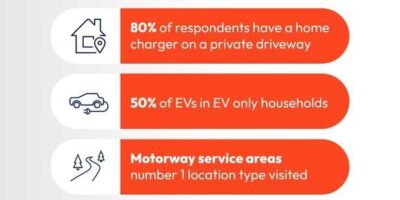Lamps, reflectors and indicators continue to be the most frequent reasons for vehicles* fail their MOTs, but it’s problems with brakes and tyres that are more likely to lead to the most serious failures, according to DVSA data analysed by the RAC.**
Failures for non-working headlights, indicators and reflectors accounted for just over a quarter (25.5%) of all MOT failures in the 12 months to March 2022, while faulty or broken suspensions represented just under a fifth (18.3%) of all failures. Problems with brakes (17%) and tyres (12%) were the third and fourth biggest reasons for an MOT failure, with bad visibility – likely cracks on windscreens – rounding up the top five, representing just 8.7% of all MOT failures.
While a third of all initial MOT tests of cars, vans and small passenger vehicles** – the equivalent to 7.3m vehicles – resulted in a fail and mean drivers need to fork out for remedial repair work, nearly one-in-10 tests – 8%, equivalent to 2.4m vehicles – worryingly result in a fail where at least one dangerous defect had been found.
In these most serious cases, where an examiner states a vehicle cannot be driven until that defect is repaired, brakes and tyres represent 88% of all such failures, emphasising just how critical it is for drivers to carry out routine checks on these items. Although the biggest causes of MOT failures have remained consistent over many years, the proportion of tyre failures has increased slightly from 10% in 2018-19 to 12% in 2021-22.
All cars require MOTs three years after first registration and annually thereafter. With drivers paying up to £54.80 for a car MOT test (class 4 vehicle) costs can soon mount up if work and parts are required, particularly if a vehicle has not been serviced regularly.
Even with cost-of-living pressures, it’s vitally important drivers keep on top of vehicle maintenance otherwise they risk falling into the false economy trap where they pay much more later for repairs. To help with budgeting and to keep things simple, the RAC now offers MOT and Service Plans which spreads the cost of two years’ servicing and MOTs, and means drivers pay just one simple and affordable sum each month – with prices starting from just £18 a month for RAC members and £20 a month for all other drivers as of March 2023.
RAC head of roads policy Nicholas Lyes said:
“Many drivers dread taking their vehicle for its annual MOT for fear they could end up having to spend lots of money on repairs in order to get it to pass. This is no doubt the case for an unlucky third of owners whose vehicles fail their MOTs initially.
“Drivers should never ignore dashboard warning lights as they could end up putting themselves or others at risk and costing themselves a lot of money with a bigger repair bill than necessary had they acted straightaway. Additionally, routine servicing helps reduce the chance of a vehicle failing its MOT as it includes a host of important basic checks.
“It’s also advisable to have someone check rear lights and indicators are working if the vehicle does not have modern dashboard warning lights. Keeping tyres properly inflated and having a smooth driving style will often help prolong the life of the rubber. And if something doesn’t sound or feel right, to get checked at a trusted garage as soon as possible.
“Understanding the cost pressures that so many households are under at the moment, we decided to launch our new MOT and Service Plan which lets drivers spread the cost of two years’ worth of servicing and MOTs, resulting in one affordable monthly payment. What’s more, drivers in the West Midlands, Manchester, Sheffield and Liverpool needn’t worry about taking their vehicle to the garage for a service as they can now book one of our Mobile Mechanics, who can do the work on a driveway or at a place of work.”
Having been in place across the UK since 1960, the scope of the MOT has been expanded over the years to include additional checks, such as vehicle emissions which were added to the list of items required to be scrutinised in 2018. In 2021-22, emissions failures represented 5% of all failures when combined with noise and leak faults.
It also underwent a major change in May 2018 with the move away from a simple pass or fail with advisories to a new five-category system. Failures were split into two classes: major and dangerous, while three pass categories were introduced: pass; pass with minor defects; and a pass with advisories.
Last year, the UK Government was reported to be considering switching the MOT from annually to every two years, a move that over half of drivers (55%) thought was a bad idea according to data gathered by a survey of the RAC Opinion Panel***.
Nicholas Lyes added: “With more than 7.3m small passenger vehicles initially failing their MOTs, and alarmingly around 2.4m of these failures having at least one dangerous defect, the idea of relaxing rules on MOT tests could very well result in making our roads far more dangerous with the number of unroadworthy vehicles increasing. We hope the Government has finally consigned such an idea to the bin.”
See the RAC website for full details of the range of service and MOT options available to drivers
*Article Source www.rac.co.uk








